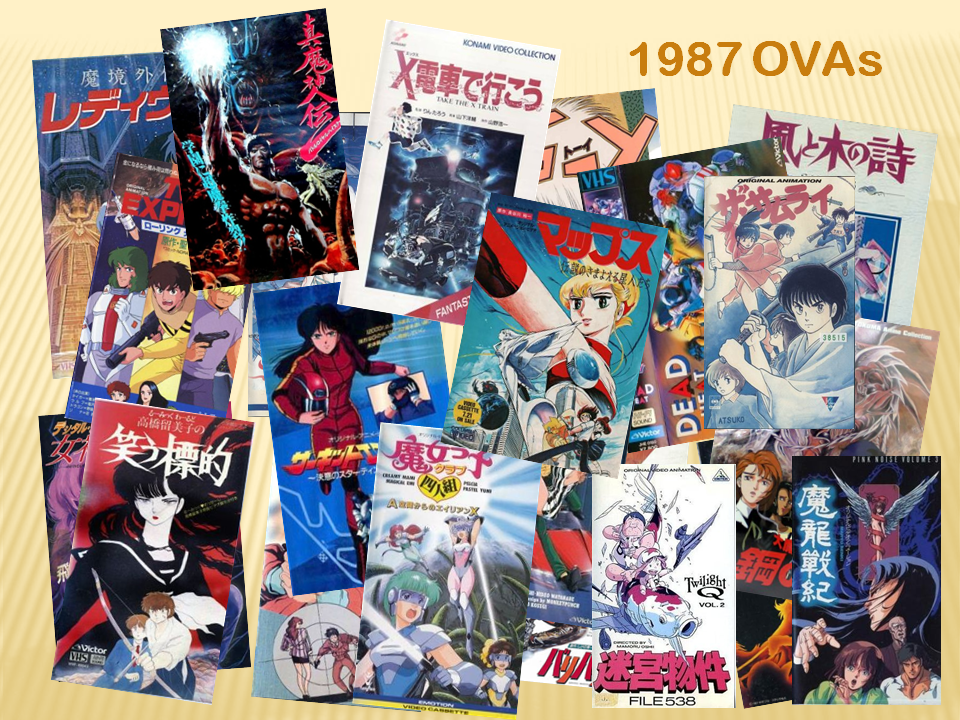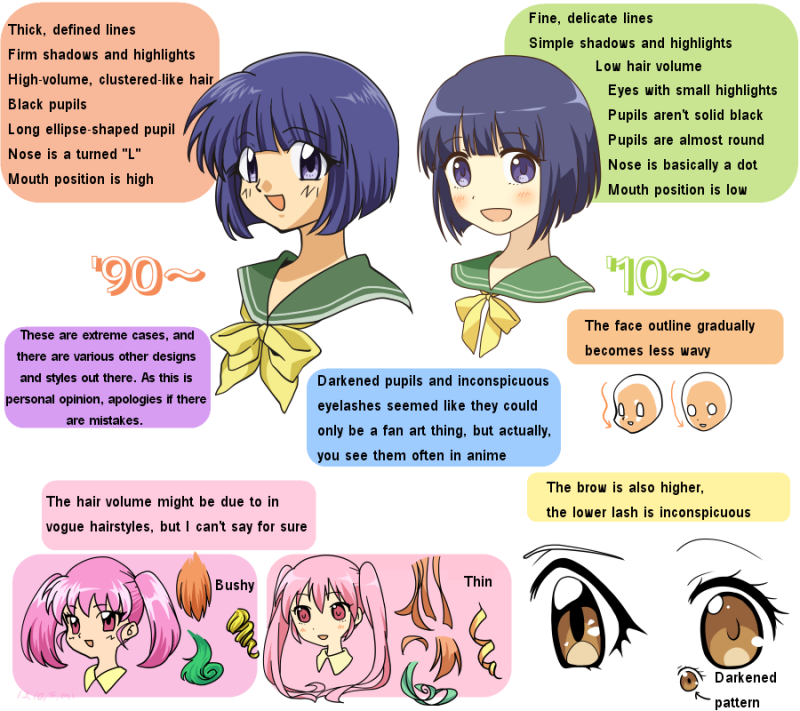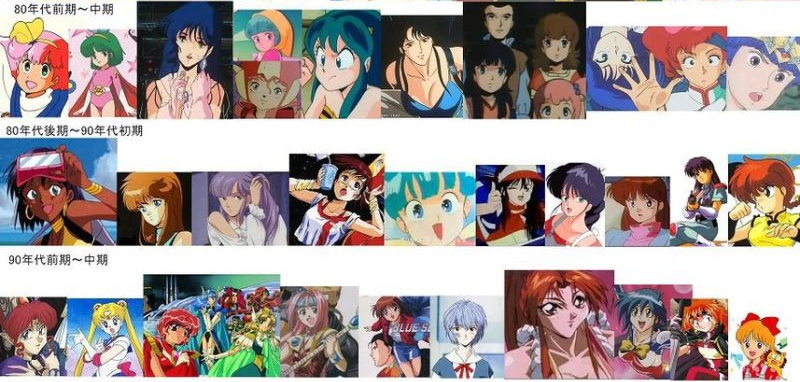Suggestion for Anime Epochs
Setting aside personal nostalgia, traditionally the “golden age” of Japanese animation has always been the 1980s. Anime’s golden age coincided with the popularization of the VHS recordable media format and home video cassette recorders. The golden era also coincided with the lifespan of the laserdisc home video format, which was introduced by Sony in 1984. And most importantly, the anime golden age was supported by Japan’s bubble economy era. Notably from 1972 to 1973 the Japanese stock market value practically doubled, and beginning from that time period the Japanese national economy steadily and significantly increased annually. On September 22, 1985, Japan joined France, West Germany, the UK, and the US as a signatory of The Plaza Accord which formally began the Japanese economic bubble that lasted through 1991. Resulting from a combination of Japan’s rapidly exploding economic prosperity and the consumer adoption of home video, Japan’s anime production industry expanded in a way like never before or since during the 1980s. During the 80’s economic bubble, Japanese investors went on an international buying spree, including purchasing the Nabisco food company, the Pebble Beach golf course, New York City’s Rockefeller Center, and Hollywood’s Columbia Pictures. Japanese investors also dumped tremendous amounts of money into the anime industry. Eleven major anime production studios opened during the 80s, including Studio Ghibli, Studio 4°C, Kyoto Animation, JC Staff, Gainax, Production I.G, AIC, and APPP. The first OVA, Mamoru Oshii’s Dallos, was released on December 16, 1983. The 1980s subsequently saw the release of more made-exclusively-for-home-video anime releases than any other time period before or since.

Because so much excess money was shoveled into the anime industry during the 1980s, the era was characterized by an unprecedented degree of creativity. Countless one-shot OVAs were produced and released strictly because investors had money to burn to fund such productions. Esoteric, experimental, and outright weird anime including Angel’s Egg, Birth, Machikado no Meruhen, Chocolate Panic Picture Show, Samy Missing 99, Meisou-ou Border, Cool Cool Bye, Battle Royale High School, Heart Cocktail, California Crisis, Dragon’s Heaven, Meikyu Monogatari, Twilight Q, and Gozensosama Banbanzai were produced during this era. Some of the most expensive anime productions ever created also came from the 1980s, including Akira, Wings of Honneamise, and Five Star Stories.
The anime golden era was also responsible for the creation of the “real robot” anime genre that included Mobile Suit Gundam, Fang of the Sun Dougram, SPT Layzner, Mobile Armor Dragonar, and Armored Trooper Votoms. The golden age introduced shounen martial arts battle anime including Fist of the North Star, St. Seiya, and Dragon Ball. The first harem anime, Urusei Yatsura, the first “isekai” anime Urashiman & Dunbine, and the first pornographic anime series all premiered during the golden age. So, in my own estimation, the “golden age” of anime can and should be dated from April 7, 1979, the premiere of the Mobile Suit Gundam television series, through to roughly 1992 when the Japanese economic bubble burst and the economic “lost decade” began.
Anime otaku in Japan and worldwide recognize the 1990s as a distinct era of anime, with some minor overlap. The logical inception date for the 90s era of anime is April 13, 1990, the premiere date of Gainax’s Secret of Blue Water anime television series. “Nadia” is remarkable because, while difficult to recognize now, at the time the show was an evolutionary step forward in production values for a weekly broadcast television anime. Secret of Blue Water brought “big budget” OVA quality to weekly television anime. Moreover, the typical art design style of anime evolved drastically and rapidly in the 90s. While golden age anime character designs were typically drawn with soft, round lines and nearly pastel colors, 90s era character designs utilized sharper, more pronounced angles and brighter, more contrasting colors.

The 90s are also noteworthy for introducing a new degree of narrative and psychological sophistication to anime that hadn’t previously existed. Anime titles including Neon Genesis Evangelion, Serial Experiments Lain, His & Her Circumstances, Berserk, Revolutionary Girl Utena, Cowboy Bebop, Gasaraki, Perfect Blue, and Ghost in the Shell brought into anime philosophical concepts including existentialism, linguistics, and the fundamental nature of humanity, as well as social concepts including alienation in the digital era, gender identity (as a debate, not as a plot device), drug abuse, and illegal immigration. This new depth and complexity in anime narrative was permissible in part because of new distribution channels for anime. The subscription satellite TV network WOWOW launched on April 1, 1991, producing original anime series including The Big O, Brain Powerd, Kaze Makase Tsukikage Ran, and Cowboy Bebop. The world’s first all anime TV network, Animax, launched on May 20, 1998. Since consumers were consciously paying for access to more mature and otaku-oriented anime, satellite TV networks sponsored the production of more sophisticated anime. Furthermore, late night anime broadcasts targeted at adult viewers had existed since September 4, 1963’s Sennin Buraku; however, the TBS network essentially launched the modern “shinya anime” (late night anime) style of anime for mature otaku viewers on April 5, 1995, when it began broadcasting Go! Inachuu Ping Pong Club.
One could potentially date the 2000s era of anime from November 7, 1998, when WOWOW broadcast Visitor, the first ever full CG anime. But Visitor historically feels more like a footnote than a revolution. So then the April 26, 2000, premiere of the FLCL OVA series might be a more appropriate designation for the launch of the anime modern era. Production IG’s FLCL was a perfect hybrid of the wildly creative, exuberant, and unpredictable style of 80s anime with the pointed, commercially conscious, otaku-centric anime style of the 90s.
I will argue that as of 2019 we’re still in the same modern era of anime that began in 2000. No appreciable tectonic shift in the typical visual design, narrative content, or production values of anime as an art style has occurred since 2000. A similar lengthy span encompasses what I suggest designation as a classic era of anime, 1953 to 1979. Known animation in Japan dates back to 1907’s Katsudo Shashin. But what fans and critics now know as “anime” began with Toei’s October 22, 1958, theatrical release of Hakujaden, and the January 1, 1963, television premiere of Astro Boy. That “classic period” of anime then lasts from 1958 until the premiere of Gundam in 1979.
Add a Comment
You must be logged in to post a comment.





Speaking of 90’s anime, what’s John’s reaction to the ‘translation’ of Eva on Netflix, anyway?
Sounds good to me, and it’s evident you’ve put some thought into this. A little Gainax-centric, but then, it’s that kind of influential studio.